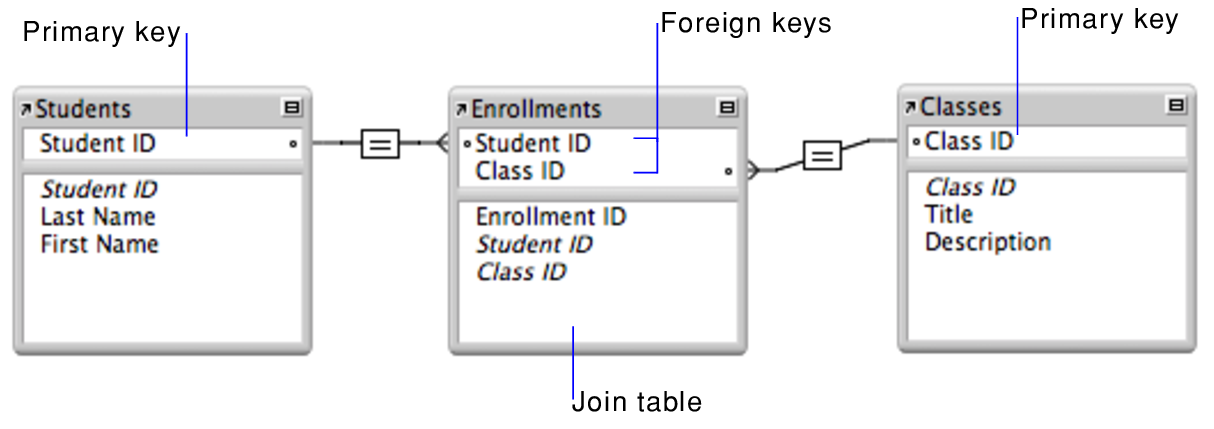Updated for ECMAScript 2017 async/await and Sequelize 6
- Create a join table and utilize it in a many-to-many relationship
- Use Sequelize's helper methods to add relationships between two different models.
When creating a many to many relationship, we need to have some way of creating that relationship. With a 1:M relationship, the id of the one is attached to the many (pets.userId in the 1:M relationship in our userapp). What do we do when there is no 1? When everything is many, we have to have some place to put the corrosponding ids.
Enter join tables! These tables have a one to many relationship with each of the relevant tables.
Often, the naming convention is to have the join table have the names of both tables. For examples if you have products and orders, the join table will often be called ProductOrders or product_orders. (More info on associative tables).
We will be expanding our data model in userapp to include toys for our pets.
sequelize model:create --name toy --attributes type:string,color:string
sequelize model:create --name pets_toys --attributes petId:integer,toyId:integer
You may be noticing that this model is plural! Doesn't that break the cardinal rule that "Models are always singular!"? According to the Sequelize documentation when using a Junction Model (a model represening an join table), the model is pluralized.
Check out the Sequelize N:M docs and the Sequelize BelongsToMany docs for more on all of the code and conventions covered in this lesson!
In order to associate pets to toys in a many to many fashion, you will need to update the associations on the pets and toys.
Many to many associations use the belongsToMany sequelize method, which takes a second options argument. Use the through option to indicate the name of the join model (in this case, pets_toys).
class pet extends Model {
...
static associate(models) {
// define association here
models.pet.belongsTo(models.user)
models.pet.belongsToMany(models.toy, { through: "pets_toys" })
}
} class toy extends Model {
...
static associate(models) {
// define association here
models.toy.belongsToMany(models.pet, { through: "pets_toys" })
}
}Don't forget to migrate after adding your new associations!
In order to add a unique toy to a pet, we need to first find (or create) a pet to associate the toy to.
Secondly, we must have a toy to attach to the pet, then we can associate them.
Some ORMs have functions to perform a bulk create on an object associations, but that kind of logic is not built in Sequelize. The list of special methods/mixins available on Sequelize N:M associations can be found in the documentation here.
async function createToy() {
try {
// First, get a reference to a pet.
const [pet, petCreated] = await db.pet.findOrCreate({
where: {
name: "Silly May",
species: "Mini Aussie",
userId: 1
}
})
// Second, get a reference to a toy.
const [toy, toyCreated] = await db.toy.findOrCreate({
where: { type: "stinky bear", color: "brown" }
})
// Finally, use the "addModel" method to attach one model to another model.
await pet.addToy(toy)
console.log(`${toy.type} added to ${pet.name}.`);
} catch (error) {
console.log(error)
}
}
createToy()Take some time to use these helper functions to add more toys and more pets! NOTE: If you are querying the pets_toys table in a psql shell you will need to wrap the table name within quotations i.e. "pets_toys".
An example of how you might use this in an express route:
app.post('/pets/toys', async (req, res) => {
try {
// First, get a reference to a pet.
const [pet, petCreated] = await db.pet.findOrCreate({
where: {
name: "Silly May",
species: "Mini Aussie",
userId: 1
}
})
// Second, get a reference to a toy.
const [toy, toyCreated] = await db.toy.findOrCreate({
where: { type: "stinky bear", color: "brown" }
})
// Finally, use the "addModel" method to attach one model to another model.
await pet.addToy(toy)
// redirect to to show the created toy
res.redirect(`/pets/${req.body.petId}`);
} catch (error) {
console.log(error)
}
})Sequelize generates helper functions that allow you to get related items. For instance, if you wanted to find all pets that used a given toy:
async function readToy() {
try {
const toy = await db.toy.findOne({
where: { type: "stinky bear" }
})
const pets = await toy.getPets()
console.log(`${pets.length} pet(s) loves the ${toy.color, toy.type}.`);
} catch (error) {
console.log(error)
}
}
readToy()Because this is a Many to Many association, all the logic from before can be turned around to search for all the toys of a particular pet!
async function readPet() {
try {
const pet = await db.pet.findOne({
where: { name: "Silly May" }
})
const toys = await pet.getToys()
toys.forEach(toy => {
console.log(`${pet.name} loves their ${toy.color} ${toy.type}.`);
})
} catch (error) {
console.log(error)
}
}
readPet()NOTE: In the above code, if the pet doesn't have any toys, that
forEachfunction will crash the nodemon server! Make sure you have error handling so your whole app doesn't shut down because one pet isn't materialistic!
Since we have a 1:M relationship between users and pets as well as a N:M relationship between pets and toys, we can get all our info through the Pet model. One of the easier ways of doing this is through the include keyword:
async function eagerLoad() {
try {
const pet = await db.pet.findOne({
where: {
name: "Silly May"
},
include: [db.user, db.toy]
})
pet.toys.forEach(toy => {
console.log(`${pet.user.firstName}'s pet ${pet.name} loves their ${toy.color} ${toy.type}.`);
})
} catch (error) {
console.log(error)
}
}
eagerLoad()If you try to use eager loading includes between two models that aren't directly related, but are linked by an intermediate model (such as finding a user and including all thier pet's toys)
...
const user = await db.user.findByPk(1, {
include: [db.pet, db.toy]
})you will see this error:
Never Fear! you can nest includes to query complex relationships!
async function readUser() {
try {
const user = await db.user.findByPk(1, {
include: [{
model: db.pet,
include: [db.toy]
}]
})
user.pets.forEach(pet => {
pet.toys.forEach(toy => {
console.log(`${user.firstName}'s pet ${pet.name} loves their ${toy.color} ${toy.type}.`);
})
})
} catch (error) {
console.log(error)
}
}
readUser()
